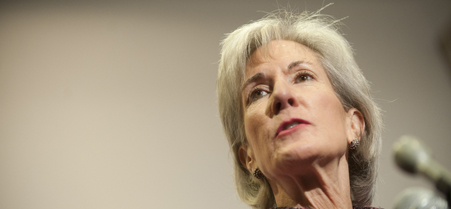HHS accelerates modeling technology to combat Medicare fraud
Officials expect automated billing analysis to reduce abuse in federal health care programs.
 HHS Secretary Kathleen Sebelius said predictive modeling is already used in the private sector.
HHS Secretary Kathleen Sebelius said predictive modeling is already used in the private sector.
In an escalating battle against Medicare fraud, the Health and Human Services Department plans this summer to begin computer analysis of medical bills nationwide. The department originally intended to introduce the program in phases during a three-year period.
Automated analysis, called predictive modeling, is intended to spot fraudulent bills among the 4.5 million claims submitted to Medicare each day.
Congress required HHS to begin using predictive modeling in the 10 most fraud-prone states by July 1. If it proved effective, HHS was to expand its use to all states and territories by 2015. But Mary Agnes Laureno, deputy director of the Center for Program Integrity at the Centers for Medicare and Medicaid Services, said deployment is being stepped up because "we're confident that it will work and it did not seem to make sense to limit it to 10 states."
Predictive modeling is the same technology credit card companies, insurance firms and financial institutions use to detect and prevent fraud.
It works by combing through vast amounts of data and building models based on patterns evident in the data. Medicare models might include data from health records, prescriptions, the cost of services and previous doctors' claims.
New billings would then be compared to the models, and claims that deviate from the norm would be subjected to further scrutiny.
"It is what credit card companies have been doing for decades," HHS Secretary Kathleen Sebelius said when describing predictive modeling in a speech last summer. "If 10 flat-screen TV's are suddenly charged to my card in one day, they know something's not quite right, so they put a hold on payment and call me right away."
Initially, though, predictive modeling of Medicare claims is not expected to function quite that fast. It won't occur in real time, but "in near real time," Laureno said. Claims will be analyzed "shortly after they have been processed," she said.
That means some fraudulent bills probably will still be paid before HHS detects the fraud. The agency will then have to try to recover the money.
That approach -- called pay and chase -- is how Medicare and Medicaid have operated for decades. Predictive modeling is among a number of steps intended to end pay and chase and detect fraud in time to prevent phony claims from being paid.
Laureno said real-time analysis of Medicare claims should be possible by 2012.
Medicare fraud is widely reported to cost about $60 billion a year, but Laureno said the department does not have a "solid estimate" of annual losses. In January, HHS and the Justice Department announced that they had recovered $4 billion in payments for fraudulent claims in 2010 -- "an unprecedented achievement," HHS officials said.
Much of the money was recovered by anti-fraud strike teams, which already have begun using predictive modeling to detect billing anomalies, Assistant Attorney General Lanny Breuer told the Senate Judiciary Committee in January.
"When we find out that Doctor A is billing at an exorbitant rate higher than Doctor B and they're near one another, we look at Doctor A right away. That's why we've been able to bring cases literally in months. So we're huge fans" of predictive modeling, Breuer said.
The Center for Medicare and Medicaid Services expects to sign two contracts this spring related to predictive modeling. One will be for a case management system and the second will be for predictive modeling algorithms, Laureno said.
HHS also is looking for automated screening technology to evaluate doctors and other medical service and equipment providers, she said. The aim is to keep bad actors out of Medicare, Medicaid and the Children's Health Insurance Program.
NEXT STORY: Veterans Stiffed Up North


